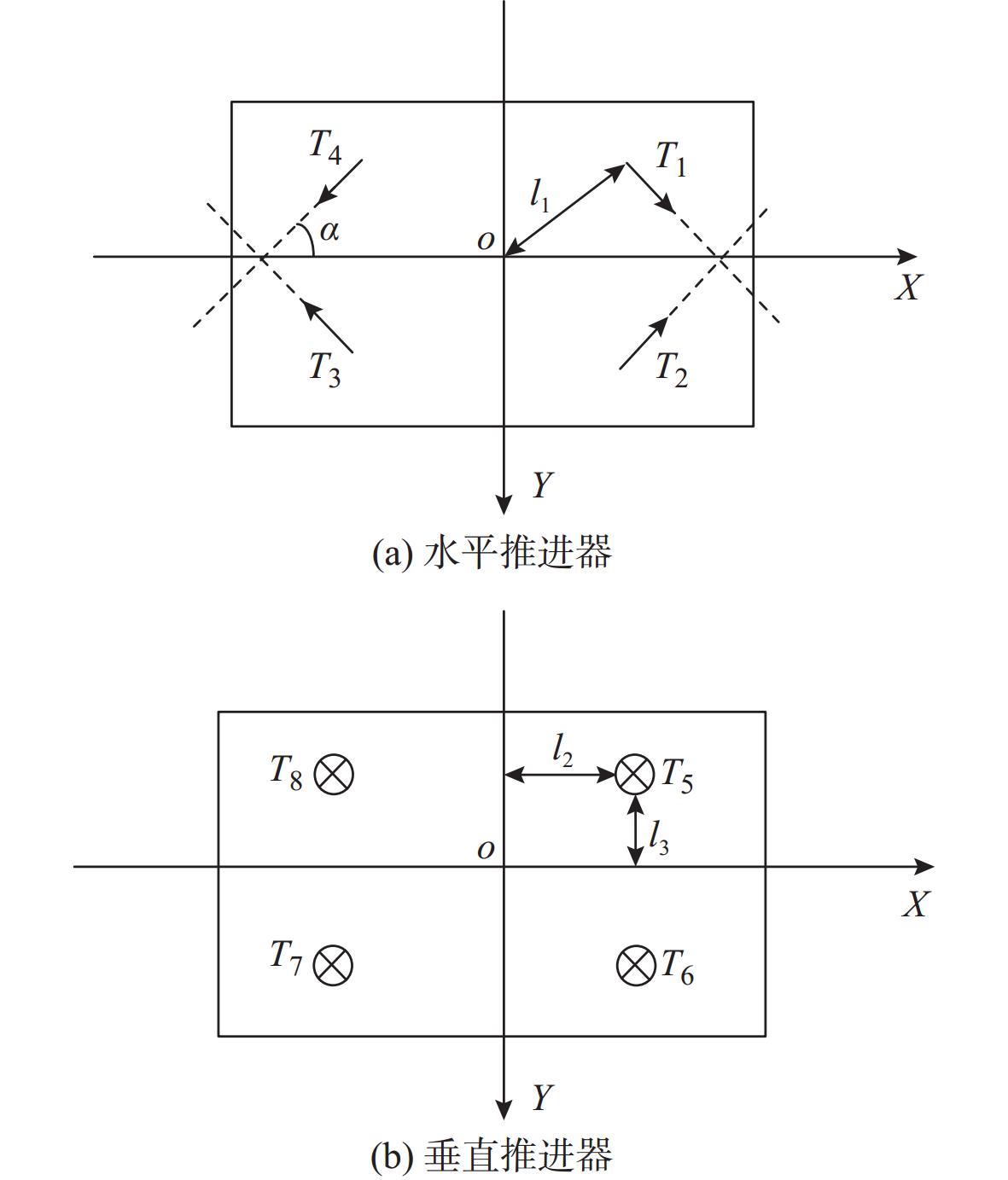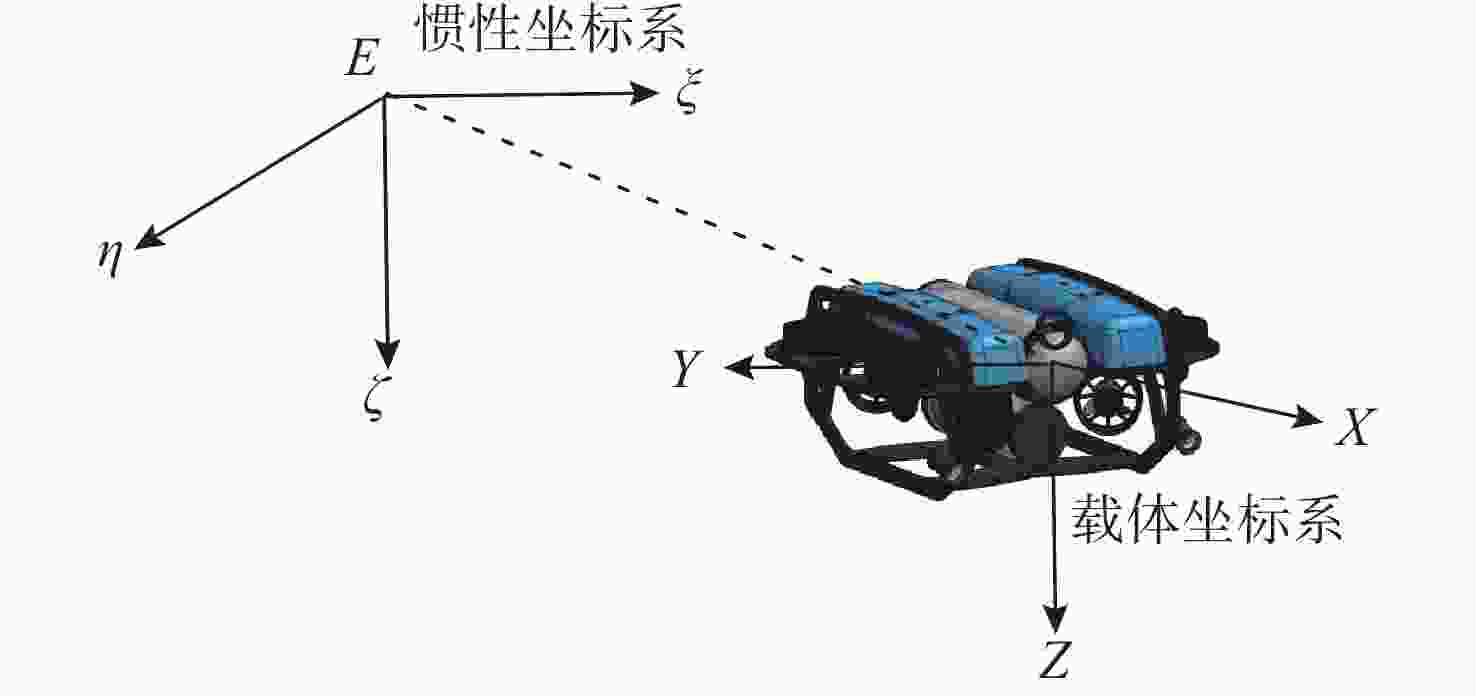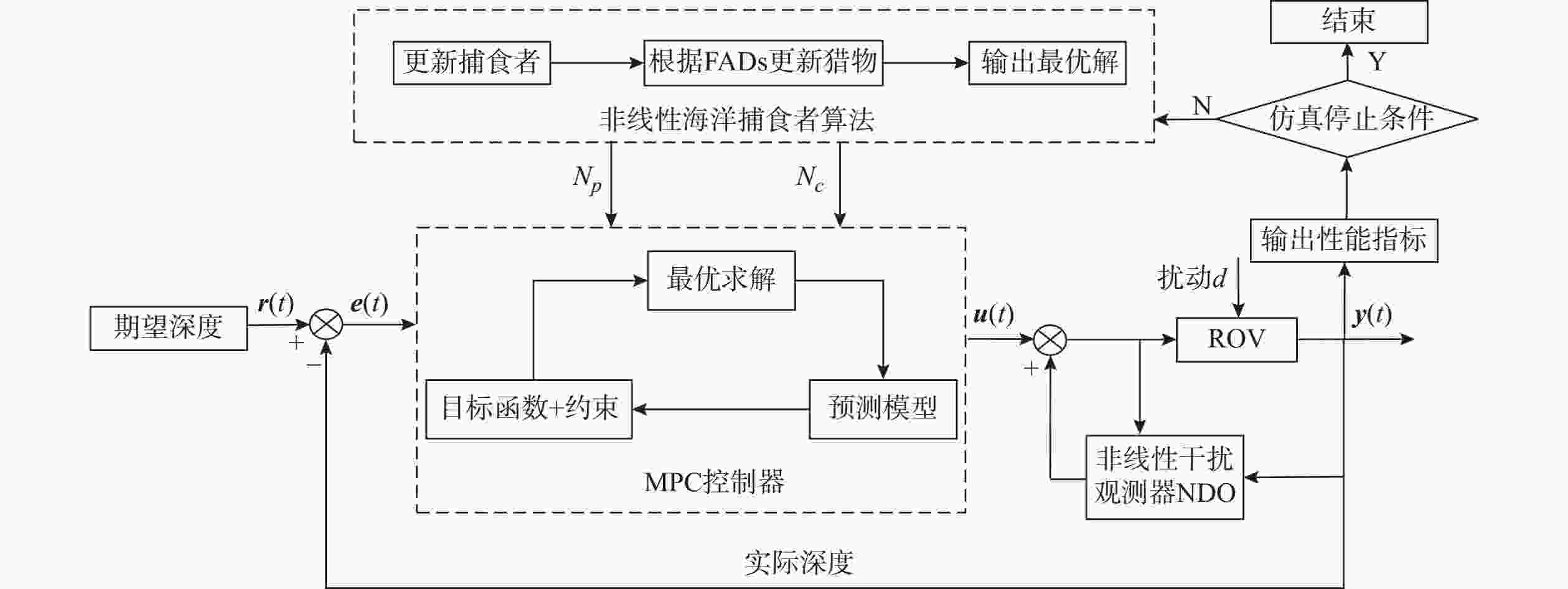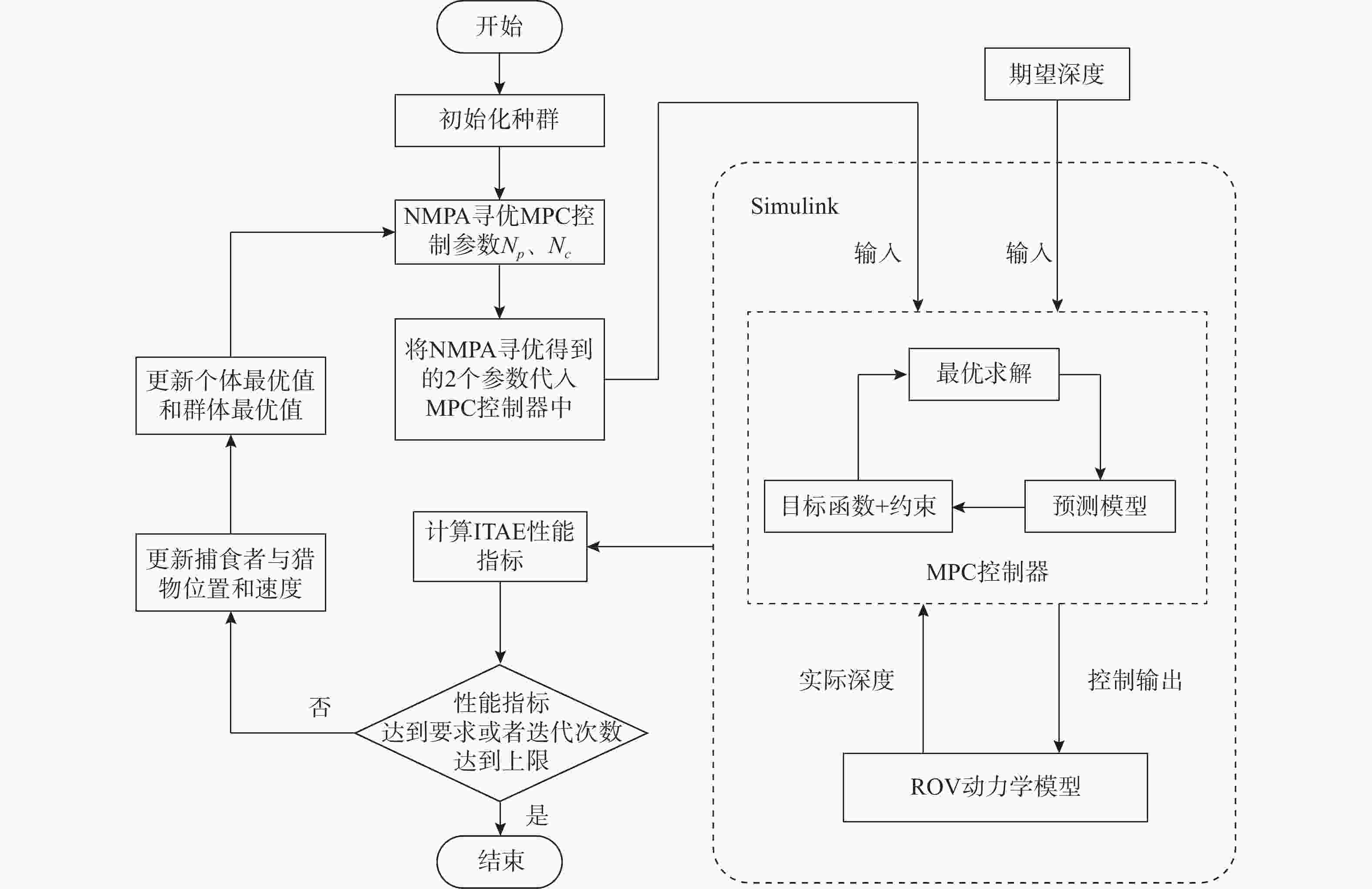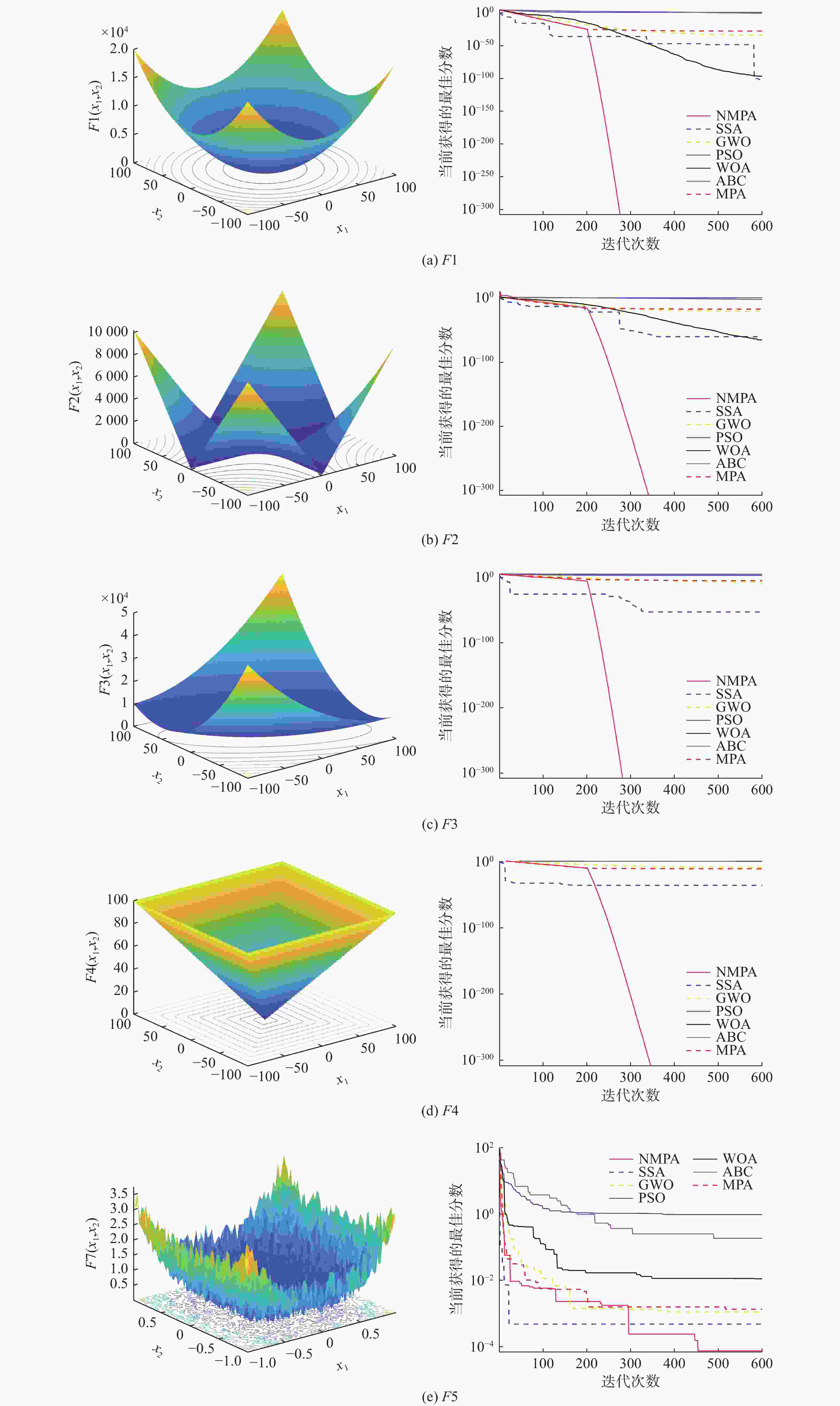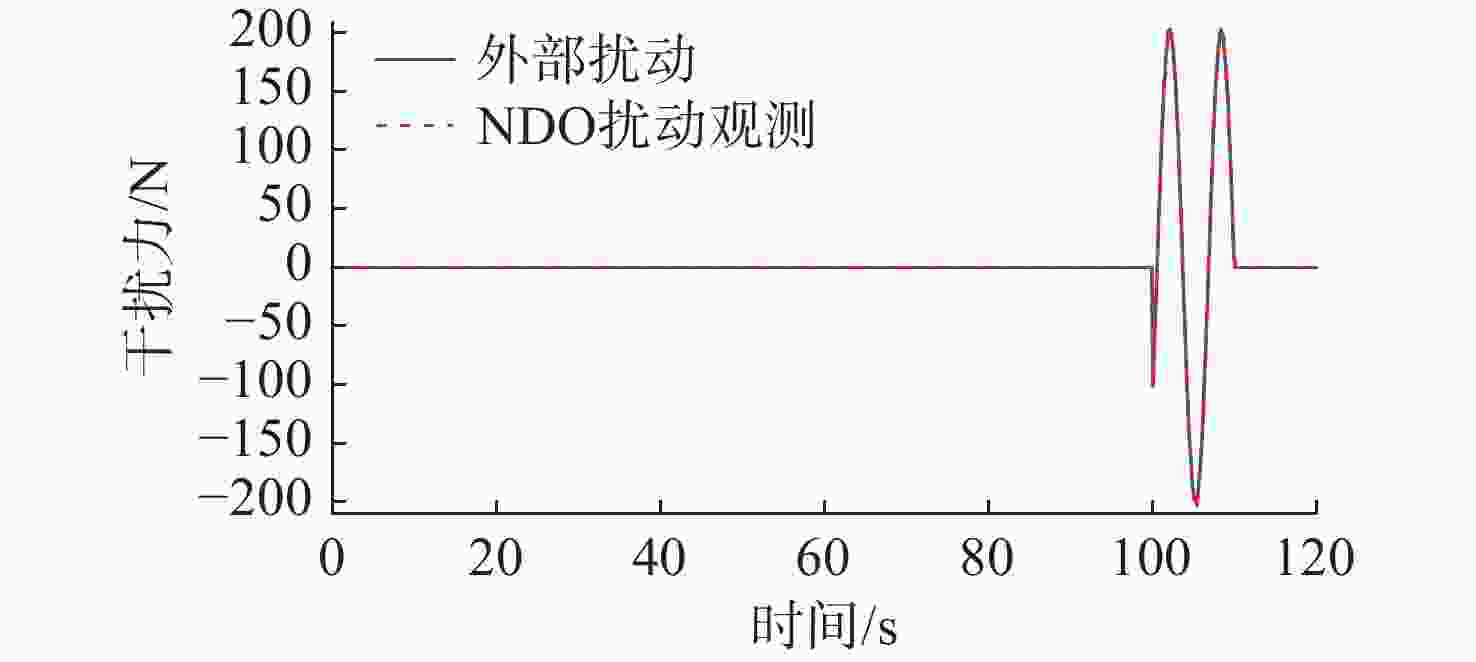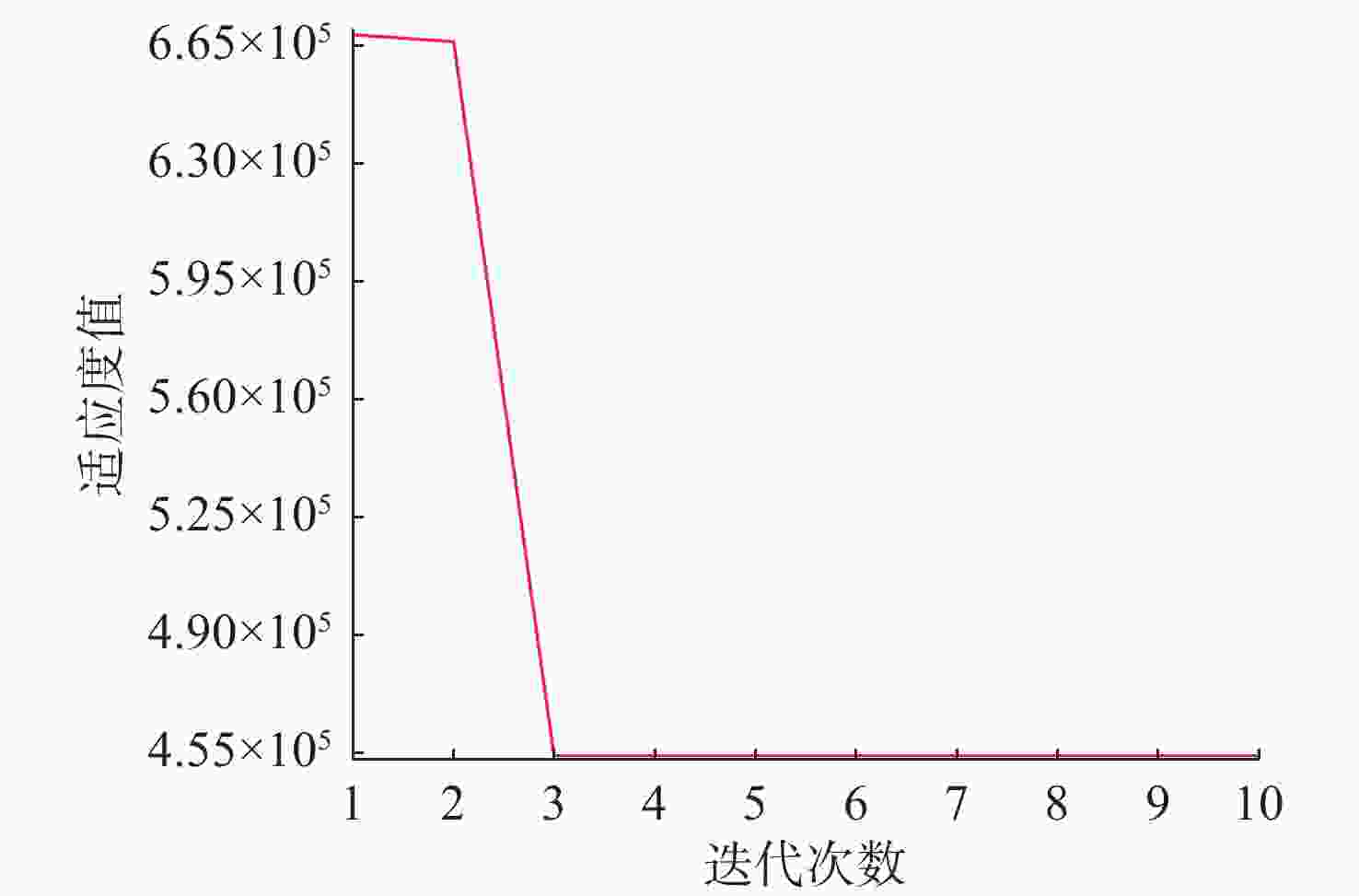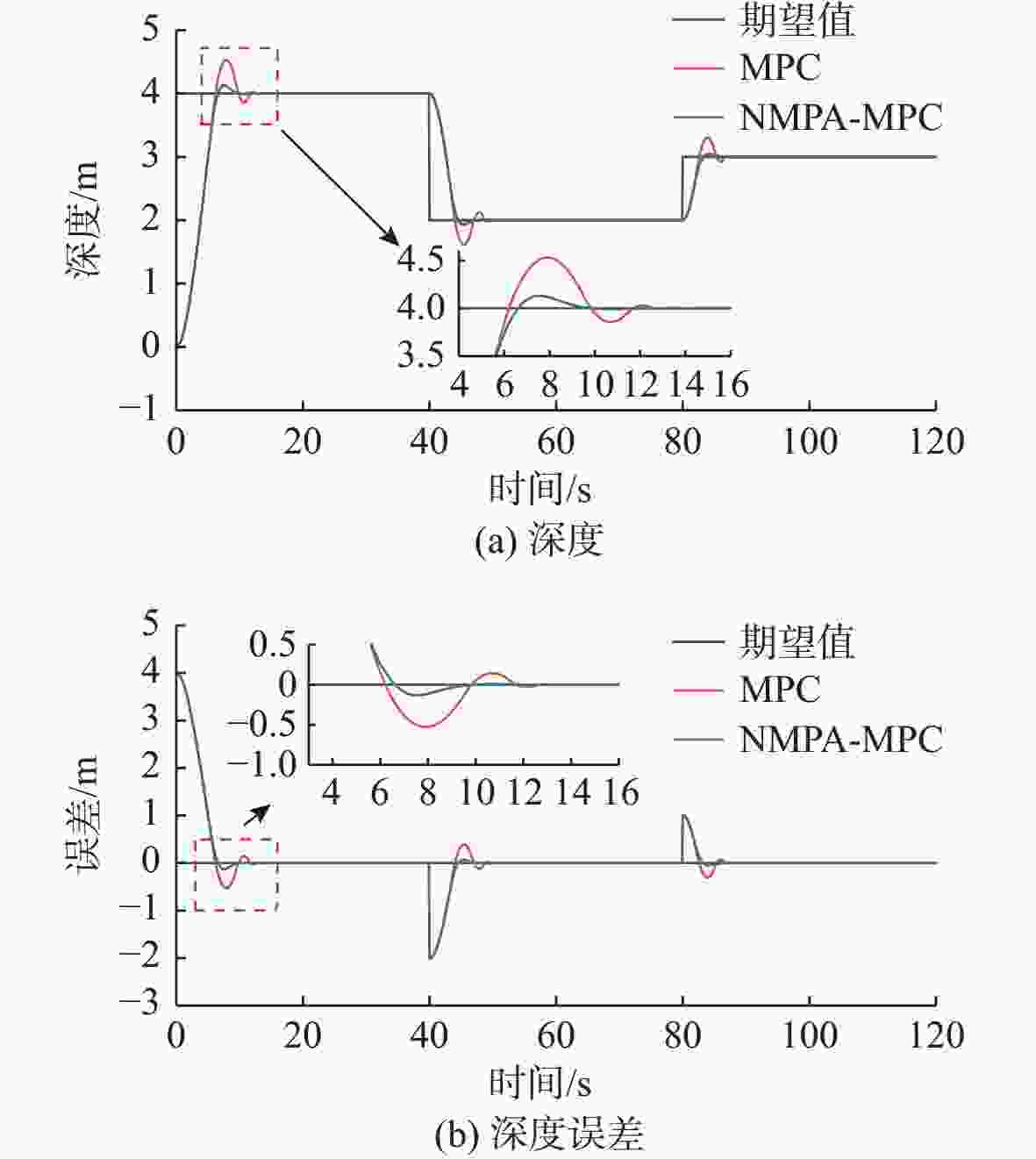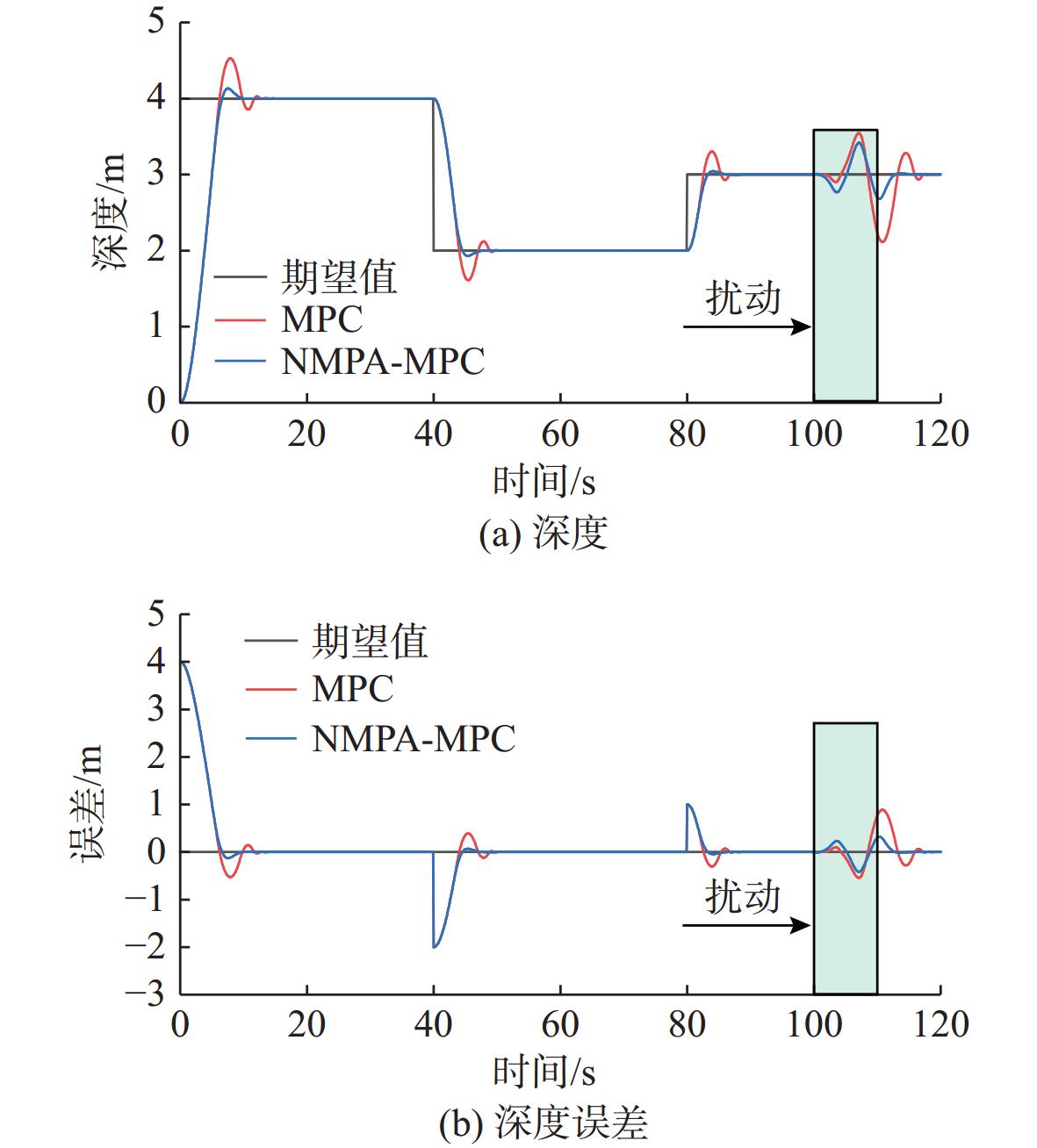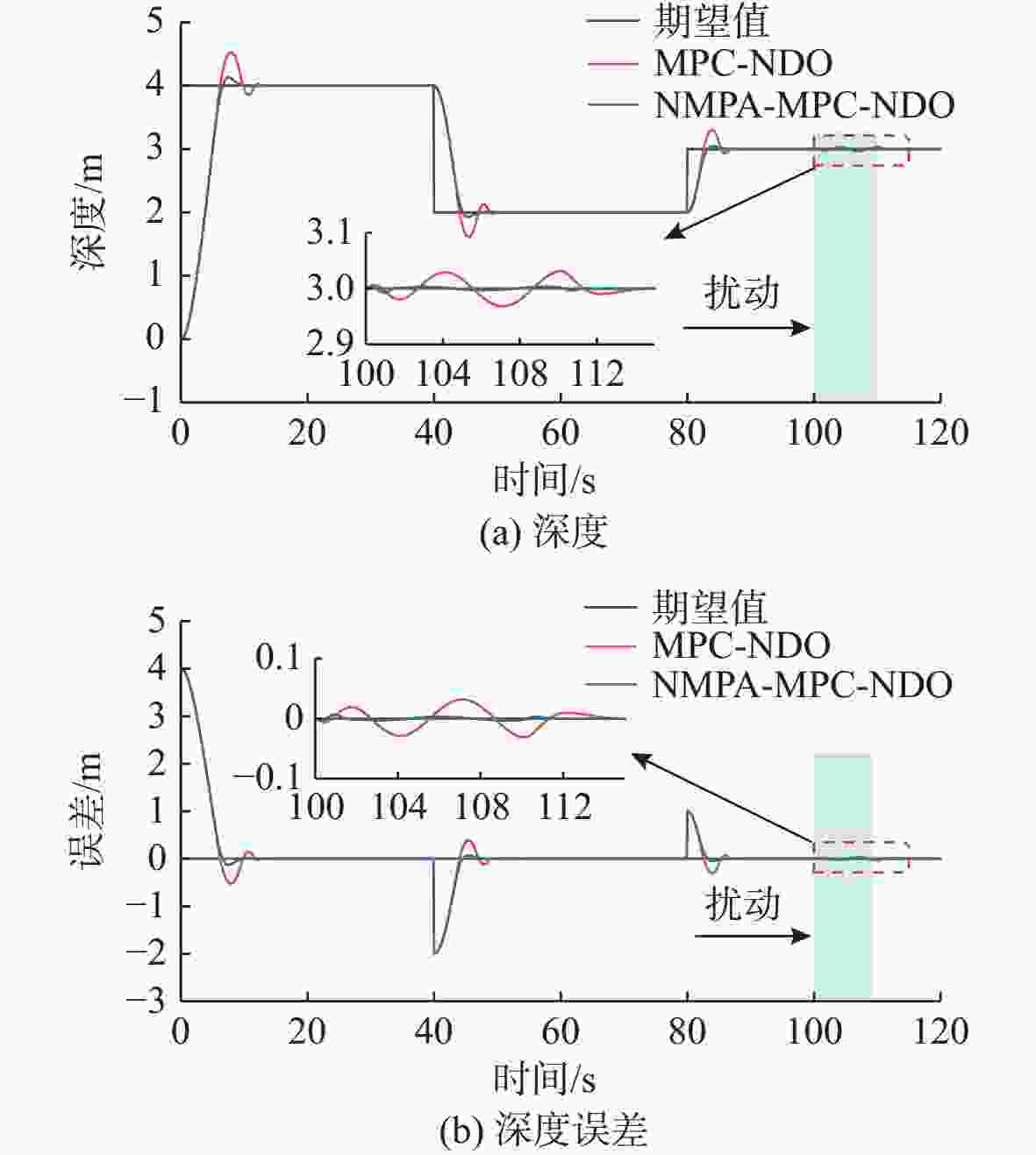Fixed Depth Control Strategy for Remotely Operated Vehicle Based on Improved Model Predictive Control Algorithm
-
摘要: 针对有缆遥控水下机器人(ROV)在复杂海洋环境中受到外界干扰影响, 导致深度控制稳定性较差的问题, 提出了一种基于改进模型预测控制(MPC)的复合控制策略。该策略旨在实现高精度定深控制, 同时显著提升ROV在突发外界扰动下的鲁棒性和抗干扰能力。首先, 引入非线性海洋捕食者算法(NMPA)对MPC的关键控制参数进行优化, 以确保ROV在复杂海洋环境中能够实现快速、精确的深度跟踪; 其次, 考虑到传统MPC算法在面对较大外界扰动时的控制效果会受到影响, 该策略引入非线性干扰观测器(NDO)实时补偿外界扰动, 以提升ROV的控制性能与鲁棒性。仿真结果表明: 所提策略使ROV的稳态时间比传统MPC缩短约30%, 超调量降低约10%; 在干扰条件下, 最大超调量降低约27.7%。该策略显著提升了ROV的定深控制性能, 表现出更高的跟踪精度和抗干扰能力。
-
关键词:
- 遥控水下机器人 /
- 模型预测控制 /
- 非线性海洋捕食者算法 /
- 非线性干扰观测器 /
- 定深控制
Abstract: To address the issue of poor depth control stability in remotely operated vehicles(ROVs) with cables due to external disturbances in complex marine environments, a composite control strategy based on an improved model predictive control(MPC) was proposed. This strategy aims to achieve high-precision fixed depth control while significantly enhancing the robustness and disturbance rejection capability of ROVs under sudden external disturbances. First, a nonlinear marine predator algorithm(NMPA) was introduced to optimize key control parameters of MPC, ensuring fast and precise depth tracking of ROVs in complex marine environments. Secondly, by considering the impact of large external disturbances on the performance of the traditional MPC algorithm, the strategy incorporated a nonlinear disturbance observer(NDO) to compensate for external disturbances in real time, improving the ROV’s control performance and robustness. Simulation results demonstrate that the proposed strategy reduces the steady-state time of the ROV by approximately 30% compared to traditional MPC and decreases the overshoot by about 10%. Under disturbance conditions, the maximum overshoot is reduced by about 27.7%. The proposed strategy significantly enhances the ROV’s fixed depth control performance, exhibiting higher tracking accuracy and better disturbance rejection capability. -
表 1 标准测试函数
Table 1. Standard test functions
函数 名称 取值范围 最小值 F1 Sphere [−100, 100] 0 F2 Schwefel 2.22 [−10, 10] 0 F3 Schwefel 1.2 [−100, 100] 0 F4 Schwefel 2.21 [−100, 100] 0 F5 Quartic Function i.e. Noise [−1.28, 1.28] 0 表 2 算法优化对比结果
Table 2. Comparative results of algorithm optimization
函数 算法 最差值 最优值 平均值 标准差 F1 GWO 4.23×10−33 1.59×10−35 4.80×10−34 1.03×10−33 SSA 1.89×10−40 0 9.37×10−42 4.19×10−41 PSO 12.53 2.61 8.81 4.67 WOA 1.64×10−89 9.64×10−104 7.95×10−91 3.18×10−90 ABC 1.44 0.20 0.57 0.23 MPA 1.35×10−27 1.40×10−30 1.31×10−28 2.38×10−28 NMPA 0 0 0 0 F2 GWO 1.29×10−19 5.27×10−21 3.37×10−20 3.08×10−20 SSA 9.32×10−33 0 7.29×10−34 2.33×10−33 PSO 18.35 6.04 10.88 2.93 WOA 9.26×10−61 9.93×10−68 6.99×10−62 2.10×10−61 ABC 0.06 0.02 0.03 0.01 MPA 7.13×10−16 3.00×10−18 1.85×10−16 1.91×10−16 NMPA 0 0 0 0 F3 GWO 6.30×10−7 8.46×10−11 8.17×10−8 1.75×10−7 SSA 1.70×10−60 0 1.07×10−61 3.89×10−61 PSO 597.75 147.48 305.40 124.85 WOA 50 679.00 29 946.81 39 755.14 4 204.85 ABC 41 812.27 25 556.45 33602.59 4 881.43 MPA 4.45×10−5 3.10×10−10 6.48×10−6 1.32×10−5 NMPA 0 0 0 0 F4 GWO 3.63×10−8 1.42×10−9 1.42×10−8 1.21×10−8 SSA 7.36×10−29 0 3.68×10−30 1.64×10−29 PSO 7.77 3.29 5.94 1.38 WOA 91.31 0.000 1 39.72 32.07 ABC 57.73 37.03 37.03 5.27 MPA 1.17×10−10 5.80×10−12 3.86×10−11 2.77×10−11 NMPA 0 0 0 0 F5 GWO 2.68×10−3 4.66×10−4 1.37×10−3 6.21×10−4 SSA 6.63×10−4 9.33×10−5 3.44×10−4 1.84×10−4 PSO 1.08 0.27 0.60 0.23 WOA 1.12×10−2 3.99×10−5 2.54×10−3 3.12×10−3 ABC 0.28 0.13 0.19 3.8×10−2 MPA 2.99×10−3 1.79×10−4 1.20×10−3 7.35×10−4 NMPA 2.59×10−4 1.39×10−6 1.11×10−4 6.82×10−5 -
[1] MANIMARAN R. Hydrodynamic investigations on the performance of an underwater remote operated vehicle under the wave using Open FOAM[J]. Ships and Offshore Structures, 2022, 17(10): 2186-2202. doi: 10.1080/17445302.2021.1979921 [2] LIU K, DING M, PAN B, et al. A maneuverable underwater vehicle for near-seabed observation[J]. Nature Communications, 2024, 15(1): 10284. doi: 10.1038/s41467-024-54600-8 [3] CHO G R, LI J H, PARK D, et al. Robust trajectory tracking of autonomous underwater vehicles using back-stepping control and time delay estimation[J]. Ocean Engineering, 2020, 201: 107131. doi: 10.1016/j.oceaneng.2020.107131 [4] SUN B, MEI M, ZHU D. A cascaded adaptive UUV tracking control design with ocean current[C]//2015 34th Chinese Control Conference(CCC). Hangzhou, China: IEEE, 2015: 4280-4285. [5] CHEN K, WANG Y, FU Y, et al. Depth control of bionic robotic fish based on fuzzy PID algorithm[J]. Journal of Physics: Conference Series, 2024, 2781(1): 012050. [6] ZHU D, GAN W, HU Z, et al. A hybrid control strategy of 7000 m-human occupied vehicle tracking control[J]. IEEE Transactions on Intelligent Vehicles, 2019, 5(2): 251-264. [7] HASAN M W, ABBAS N H. Disturbance rejection for underwater robotic vehicle based on adaptive fuzzy with nonlinear PID controller[J]. ISA Transactions, 2022, 130: 360-376. doi: 10.1016/j.isatra.2022.03.020 [8] GAN W, ZHU D, HU Z, et al. Model predictive adaptive constraint tracking control for underwater vehicles[J]. IEEE Transactions on Industrial Electronics, 2019, 67(9): 7829-7840. [9] WANG Y, ZHANG Y. Coordinated depth control of multiple autonomous underwater vehicles by using theory of adaptive sliding mode[J]. Complexity, 2018, 2018(1): 4180275. doi: 10.1155/2018/4180275 [10] ELMOKADEM T, ZRIBI M, YOUCEF-TOUMI K. Trajectory tracking sliding mode control of underactuated AUVs[J]. Nonlinear Dynamics, 2016, 84(2): 1079-1091. doi: 10.1007/s11071-015-2551-x [11] WEI Y, AN D, LIU J, et al. Intelligent control method of underwater inspection robot in netcage[J]. Aquaculture Research, 2022, 53(5): 1928-1938. doi: 10.1111/are.15721 [12] 邓旭, 刘子钰. 基于自适应离散滑模趋近律的UUV深度控制[J]. 船舶工程, 2024, 46(S1): 454-459. [13] 闫景昊, 王伟然, 杨冠军, 等. 基于拉盖尔函数的AUV自适应预测轨迹跟踪[J]. 电光与控制, 2023, 30(1): 15-20. doi: 10.3969/j.issn.1671-637X.2023.01.003YAN J H, WANG W R, YANG G J, et al. Adaptive predictive trajectory tracking of AUV based on Laguerre function[J]. Electronics Optics & Control, 2023, 30(1): 15-20. doi: 10.3969/j.issn.1671-637X.2023.01.003 [14] 刘甜田, 陆群, 赵伟, 等. 一种基于固定时间稳定理论的移动机器人NMPC方法[J]. 计算机与数字工程, 2022, 50(11): 2423-2427. doi: 10.3969/j.issn.1672-9722.2022.11.014LIU T T, LU Q, ZHAO W, et al. A NMPC method for mobile robots based on fixed-time stability theory[J]. Computer and Digital Engineering, 2022, 50(11): 2423-2427. doi: 10.3969/j.issn.1672-9722.2022.11.014 [15] ZHU D Q, ZHANG H P, LIU C X. Tracking controller based on model prediction control for remotely operated vehicle for thruster fault[J]. Journal of Marine Science and Technology, 2022, 27(2): 840-855. doi: 10.1007/s00773-022-00879-5 [16] 孙志伟, 李聪. 基于横纵向MPC的智能车换道控制算法[J]. 计算机仿真, 2023, 40(4): 461-468. doi: 10.3969/j.issn.1006-9348.2023.04.089SUN Z W, LI C. Lane change control algorithm of intelligent vehicle based on lateral and longitudinal MPC[J]. Computer Simulation, 2023, 40(4): 461-468. doi: 10.3969/j.issn.1006-9348.2023.04.089 [17] 张硕, 吴雨洋, 汪洋, 等. 基于模型预测控制的无人车编队避障方法[J]. 北京理工大学学报, 2025, 45(1): 34-41.ZHANG S, WU Y Y, WANG Y, et al. Formation obstacle avoidance based on model predictive control for unmanned vehicles[J]. Transactions of Beijing Institute of Technology, 2025, 45(1): 34-41. [18] PAN J, ZHANG P, WANG J, et al. Learning for depth control of a robotic penguin: A data-driven model predictive control approach[J]. IEEE Transactions on Industrial Electronics, 2022, 70(11): 11422-11432. [19] TRAN H N, PHAM T N N, CHOI S H. Robust depth control of a hybrid autonomous underwater vehicle with propeller torque’s effect and model uncertainty[J]. Ocean Engineering, 2021, 220: 108257. doi: 10.1016/j.oceaneng.2020.108257 [20] 王红都, 高枫, 黎明, 等. 基于ESO的水下机器人机械臂系统鲁棒模型预测控制[J]. 水下无人系统学报, 2023, 31(6): 827-838. doi: 10.11993/j.issn.2096-3920.2022-0074WANG H D, GAO F, LI M, et al. ESO-based robust model predictive control for undersea vehicle manipulator system[J]. Journal of Unmanned Undersea Systems, 2023, 31(6): 827-838. doi: 10.11993/j.issn.2096-3920.2022-0074 [21] GAN W Y, ZHU D Q, JI D X. QPSO-model predictivecontrol-based approach to dynamic trajectory trackingcontrol for unmanned underwater vehicles[J]. Ocean Engineering, 2018, 158: 208-220. doi: 10.1016/j.oceaneng.2018.03.078 [22] 唐军, 陈善颖, 谢彬, 等. 基于有限时间干扰观测器的改进模型水下机器人自适应鲁棒容错控制[J]. 科学技术与工程, 2024, 24(11): 4574-4582. doi: 10.12404/j.issn.1671-1815.2302720TANG J, CHEN S Y, XIE B, et al. Improved model unmanned underwater vehicle adaptive robust fault-tolerant control based on finite time disturbance observer[J]. Science Technology and Engineering, 2024, 24(11): 4574-4582. doi: 10.12404/j.issn.1671-1815.2302720 [23] FOSSEN T I. Guidance and control of ocean vehicles[M]. New York: John Wiley & Sons Inc, 1994. [24] SADIQ A S, DEHKORDI A A, MIRJALILI S, et al. Nonlinear marine predator algorithm: A cost-effective optimizer for fair power allocation in NOMA-VLC-B5G networks[J]. Expert Systems with Applications, 2022, 203: 117395. doi: 10.1016/j.eswa.2022.117395 [25] 尹晖, 熊治国, 高翔, 等. 基于PSO的自抗扰飞行控制律参数优化方法[J]. 空军工程大学学报, 2013, 14(3): 19-22, 32.YIN H, XIONG Z G, GAO X, et al. Parameters optimization of flight control law using ADRC for super-maneuverable aircraft based on PSO[J]. Journal of Air Force Engineering University, 2013, 14(3): 19-22, 32. [26] CHEN W H. Disturbance observer based control for nonlinear systems[J]. IEEE/ASME Transactions on Mechatronics, 2004, 9(4): 706-710. doi: 10.1109/TMECH.2004.839034 [27] WU C J. 6-DOF modelling and control of a remotely operated vehicle[D]. Adelaide, Australia: Flinders University, 2018. [28] RICHARDSON M D, BRIGGS K B. In-situ and laboratory geotechnical measurements of seafloor sediments: Implications for underwater vehicle operations[J]. IEEE Journal of Oceanic Engineering, 1999, 24(4): 404-415. [29] BLONDEL P, MURTON B J. Handbook of seafloor sonar imagery[M]. Newyork, USA: Wiley, 1997. -




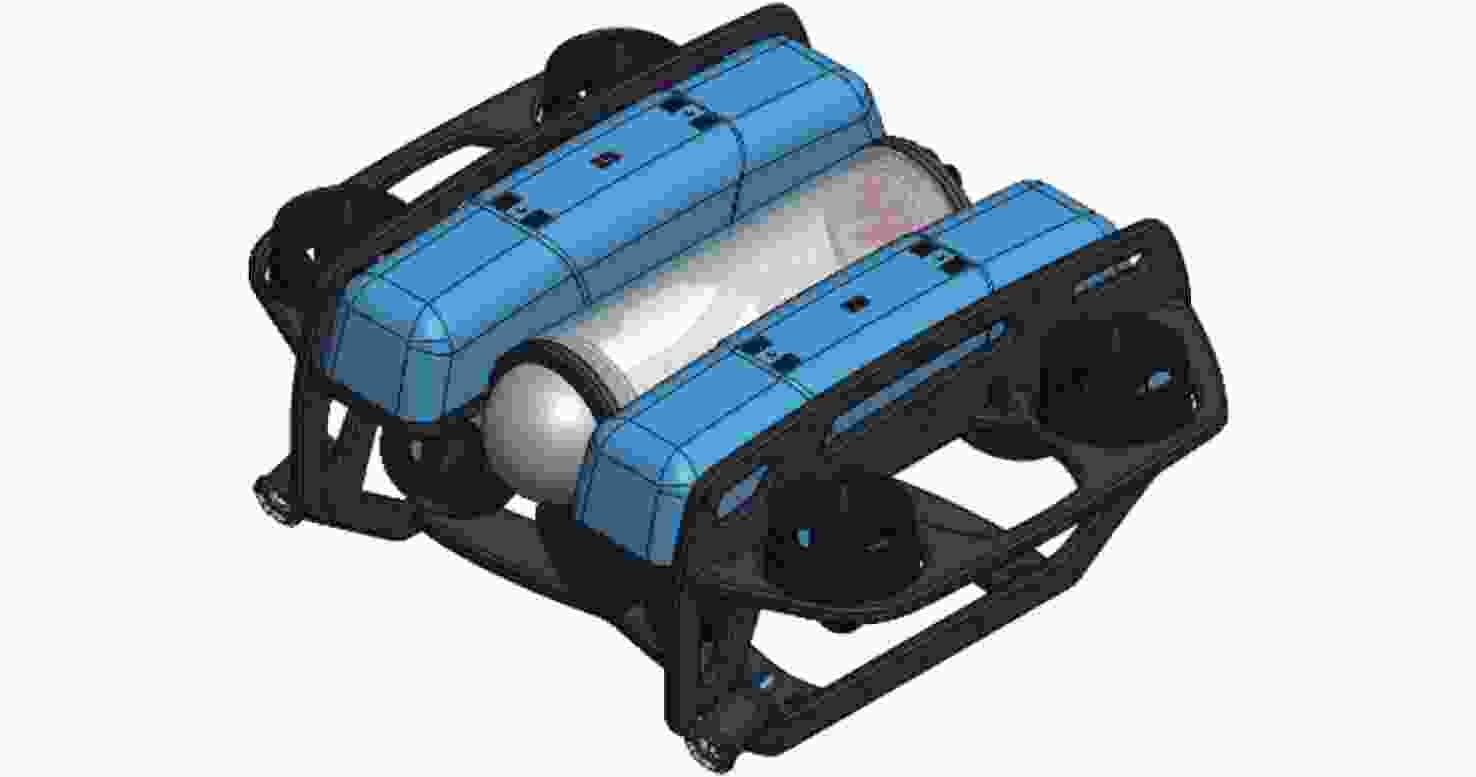
 下载:
下载:
